Cracker-crust pizza: you’ll need this French dowel rolling pin giveaway WINNERS HAVE BEEN CHOSEN
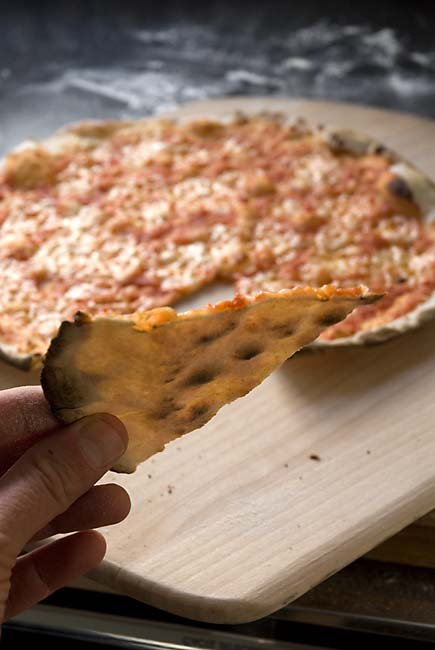
This pizza is so thin and crackly that light shines through it! It’s much easier to achieve perfection with this Tuscan specialty than you might think. You will need a good rolling pin, and the good folks at JK Adams in Vermont have a terrific French dowel rolling pin that we like (especially the thinner 1 1/2″ model), and they’re providing five of them to give away in a drawing here. We prefer these tapered handle-less pins to the handled straight rollered versions–seems that you get better control of thinly-rolled items…
To enter the drawing for the rolling pin: anyone posting a comment to this post will automatically be entered–we’re giving away one of these pins to five lucky winners. Contest closes and winners will be selected seven days after this original post. Usual rules apply (we’ll need your e-mail to notify you, we’ll only ship to a U.S. address, only one entry allowed, and you must respond within 24 hours if you’re a winner). Winners have been chosen and notified…
Everyone knows that cracker-crust pizza needs to be stretched and rolled really, really thin in order to get a crunchy and super-thin result. But before you even start with that, two things to do:
- Pre-heat your oven for 30 minutes or longer, with a glazed or unglazed baking stone in the bottom third of the oven, and use the highest heat your oven allows (for me that’s 550 degrees F). It actually takes my stone about 40 minutes to completely preheat–guaranteeing a great crust.
- Prepare all your toppings before you start stretching the dough: Otherwise the dough will glue itself to the pizza peel while it’s waiting to be topped and you’ll never get it into the oven. Today I used a smooth and thick but plain tomato sauce (less than 1/4-cup), and about 1.5 ounces of fresh mozzarella. Cracker-crust pizzas need very little topping– if you use lots, it won’t crisp and the whole thing may turn to porridge.
In Artisan Pizza and Flatbread in Five Minutes a Day, our cracker-crust pizzas call for a dough-round that’s only 1/16-inch of an inch thick. Maybe there’s someone out there who can do that with their bare hands, but I can’t. I need a rolling pin, and I’ve come to love the handle-less French milled rolling pins, which give you better control in this situation (the JK Adams model in this giveaway is a beauty, milled from super-hard maple). Use a small ball, about 4 ounces (peach-sized) of refrigerated dough from one of our recipes. You need “lean” dough here (those not enriched with eggs and lots of sweetener) from our books: white dough, or the whole-grain are just two examples, see the books for more. Using some whole grain makes it easier to get very thin–plain white dough is the most difficult to stretch because of its gluten-strength. If you use a large ball, you’ll have a very hard time getting it this thin:
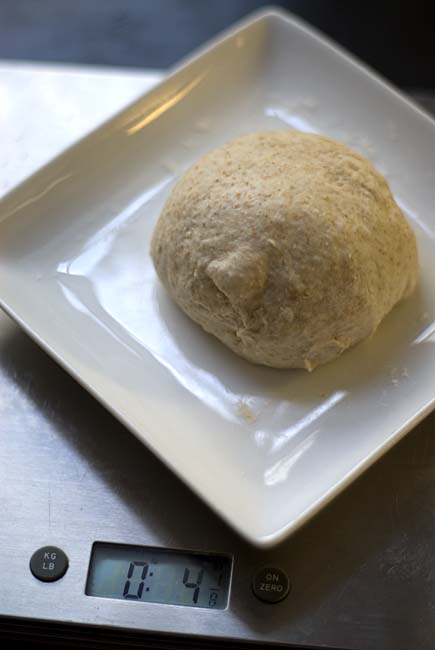
(You don’t really have to weigh it, but it can be nice when you’re learning). Briefly shape it into a ball as in our other posts, and if you have time, let the ball rest under plastic wrap or an overturned bowl at room temperature for up to 60 minutes; that will make it relax and be easier to roll out. So start with the rolling pin and your fingers…

It’s pretty easy to get it to 1/4-inch thick, and then 1/8-inch. But for my ball of dough today, it needed to get to a diameter of about 14 inches in order for the thickness to be down to 1/16-inch…

Use plenty of flour…
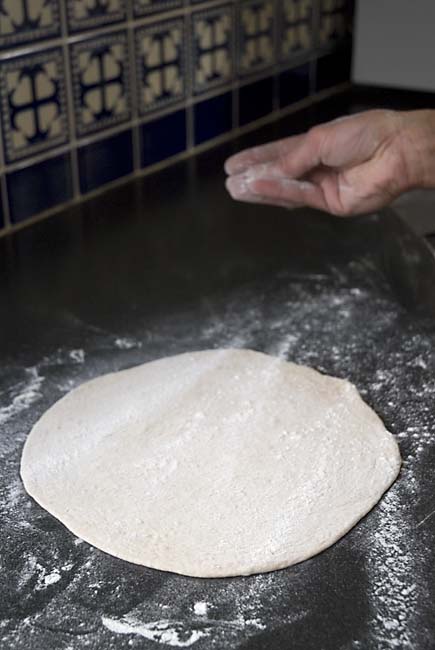
Getting it to 1/16-inch takes a bit of perseverance. Some tricks:
- If it just won’t “relax” and thin out, cover the partially-stretched dough-round with plastic wrap and give the gluten five or ten minutes to relax.
- Use the dough’s own stickiness to force it thin: although you’ll need to dust with lots of flour, allow it to stick to your work surface a little. That pins it down and allows the work surface to oppose its natural tendency to shrink back into its thicker self.
- Use a dough scraper: It’s very difficult to make cracker crust without one, because this dough will try to stick to the work surface, and as I say, you want a little of that. But periodically “un-stick” it, like so:
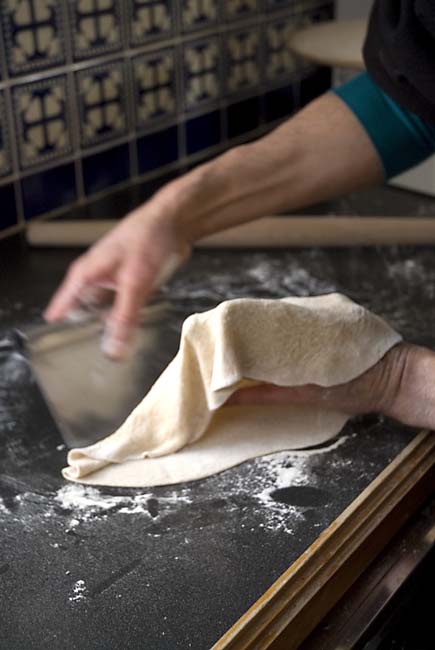
As you gather it up in your other hand, you can see that the top surface is going to need lots of dusting flour. Don’t be stingy with it; most of it will fall off as you work with it. You know you’re getting close when the dough is looking paper-thin, and draping your hands like a glove:
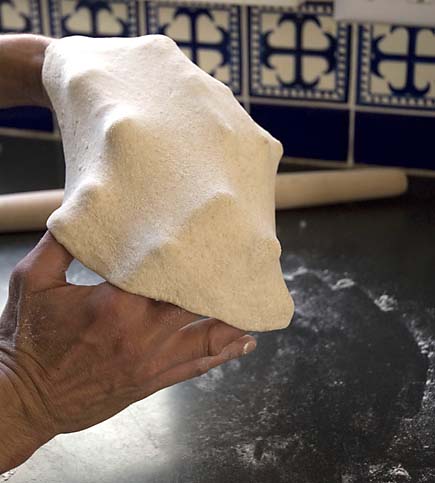
When you get to 1/16-inch thickness, place the dough-round onto a pizza peel dusted with flour. Periodically shake the peel to be sure that you’re not sticking. Start with the sauce; you can use a spoon, but a pastry brush is quite handy for the thin coating of sauce that’s called for here:

… OK, maybe a little more than that, but don’t overdo it:

In our pizza book, our cracker-crust pizzas don’t call for the big cheese chunks that work so nicely on Neapolitan-thickness pizza– go for grated cheese if you’re using commercial mozzarella, or small pieces of fresh mozzarella as in these pictures (you really can’t grate the fresh stuff, it just disintegrates). And not so much– 1.5 ounces is enough here:

… so you’re spacing the cheese a little. Now slide it onto the pre-heated stone (more on that technique in the book). Hopefully the 30-minutes preheat was enough, but if you’re not getting the crispiness you like, next time preheat for up to an hour:

In my oven, which runs hot (and I’m never getting that fixed), this was ready in 5 minutes. If your oven runs cooler, you’ll need more time, but check early– this is thin stuff and you don’t want it burning. Check your oven with a thermometer or it can be challenging to get the crispiness you want. A little scorching is OK– see the blackened bits on the underside and at the edge, and yes, the light should shine through it:
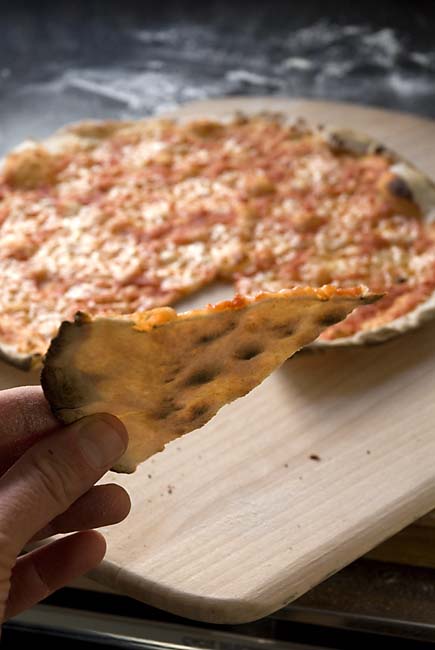
Give my regards to Siena!
love, want, need
Can’t wait to try this recipe and that rolling pin would be wonderful!
I’ve got to try this!
I need to try a pizza like this. Love making homemade pizza!
I love your books and would love a rolling pin for making this delicious cracker crust!
I’ve been baking a lot of bread (and variations) from all 3 of your books but haven’t tried to roll pizza that thin. My family likes more “bread” and it would be interesting to let them try very thin crust. How do you prevent this very thin crust from tearing?
Hi Valentina,
The trick is to roll it out on enough flour so it won’t stick to the pin or the counter, if it is moving freely, it is easier to pick up without tearing it.
Cheers, Zoë
All it takes is patience and a good rolling pin.
i LOVE thin crust pizza. I would be delighted to win this rolling pin and actually have success! Thank you for the opportunity.
Every Friday is pizza night at our house! I would love to win this rolling pin to be used for our pizza making on Fridays!!
Looks Great lets Eat!!!!
I love a good rolling pin and the pizza looks so yummy
Looks delicious….will it work with a gluten free recipe?
Would love to win a new rolling pin! Thin pizza means lower calories!
Hmmmm! Excellent guidance here for the thinnest possible crust. I never thought before that I could attain this, but with these guidelines and (hopefully) that rolling pin, I may just be able to pull it off! We have pizza often enough that I just made a batch of dough tonight to cold ferment in the fridge for Sunday or Monday’s dinner.
Looks great
Homemade pizza – one of my favorie meals. Love your books and recipes!
What an enjoyable post. By the end of it I could taste the cracker crust! It’s been years since I made pizza and I don’t know why I stopped; going to look into making another one soon.
This looks delicious! And…I would love to make it with a new rolling pin!
thank you for the opportunity to win this. I’d love to win it and try it out.
We tried every recipe variation on pizza crust we found ’til we found the few we really love. I’ll certainly try this one immediately…thank you for all the research and testing. It IS appreciated!
Wow, that looks incredible! I love crunchy thin-crust pizza. I have your bread books, but the pizza and flatbread one gets the biggest use in my house – Friday nights are usually pizza nights!
I’ve made lots of your bread, but I’ve not tackled the pizza, yet. That looks amazing!
Great tutorial. I can’t wait to try it this weekend. Thank y’all!
A great tutorial! Thanks!
this is my favorite kind of crust! so nice to know how to do it now.
I LOVE thin crusts!
That pizza looks amazing! Great post!
Super thin crust pizza is tops in my book. Will be trying this recipe in the near future.
I would love to add one to my kitchen tools box!Thanx for the giveaway op…
I like thin crust pizzas, especially when the crust is crispy. I can’t wait to try this.
Looks delicious!
Hope I can get it that thin – I never seem to be as dexerous as Jeff or Zoe.
Great tutorial! Giving it a bit of rest between stretches really helps.
looks delicious! I need a new rolling pin!
Love thin crust pizza! Need to try this.
I had pizza like this in Italy and it was divine! Can’t wait to try this at home.
Looks delicious. Can’t wait for our new house with a bigger fridge so I can start doing this kind of bread again!
This looks divine, I’m still working towards getting a crust thin enough for something like that. I think using my white dough may be holding me back from true thinness….
Looks delicious! Can you make two at once if you have a convection oven?
Looks fantastic! I want to try it with the whole-grain dough!
Have always wanted one of these, but just never got to picking one up. Have my great grandmother’s heavy solid maple pin – probably crush that poor pizza dough!
Love this – can’t wait to try it!
Excited to have found this website. My husband is so eager to begin experimenting with making his own bread and pizzas and baking it in his Big Green Egg. This rolling pin would be a wonderful surprise!
Pick me! Pick me!
love the fancy rolling pin!
Nice pie!
Now I know why I can’t get my crusts thin enough. Thanks for the info. Hope one can be mine.
Mmmmmmm… our favorite way to make and eat pizza – super thin and crispy.
Maybe my husband will finally stop complaining about not having thin and crispy crust!
This looks amazing – now to get that rolling pin!! Thanks for posting.